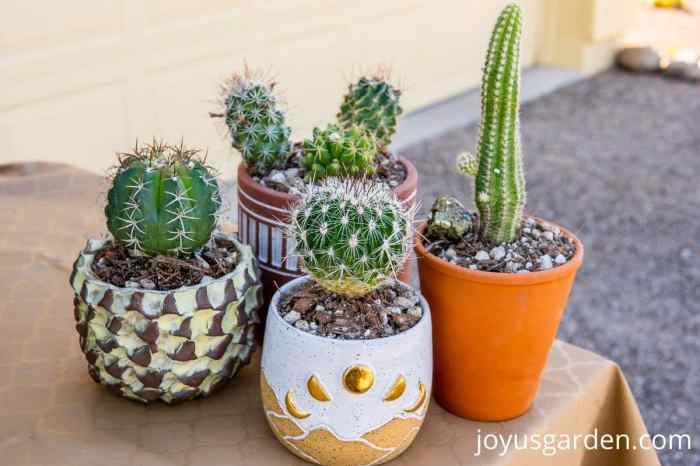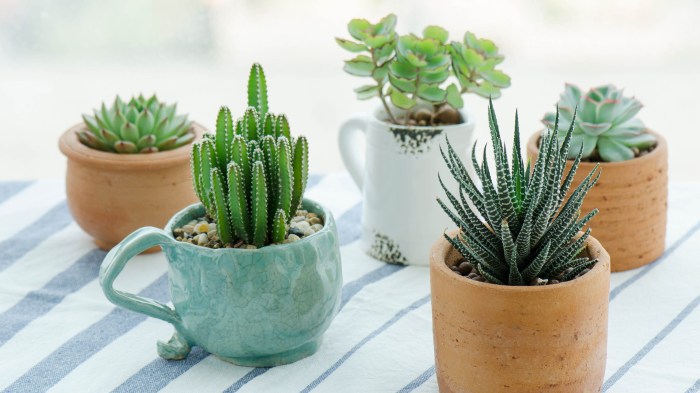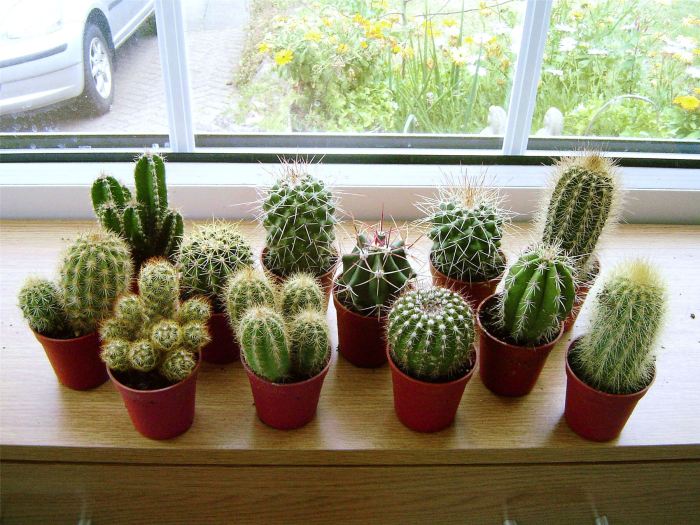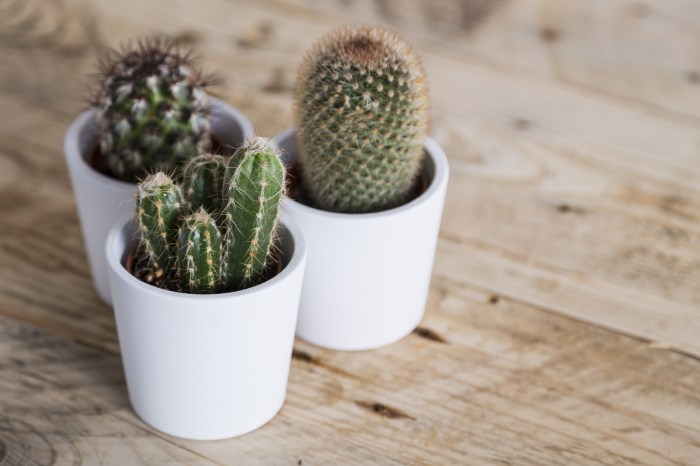How to take care of a mini cactus – Embark on a horticultural adventure with our comprehensive guide to caring for mini cacti. These diminutive desert dwellers, with their charming shapes and vibrant hues, bring a touch of nature’s artistry to any space. Learn the secrets of watering, lighting, soil, fertilizing, and repotting to ensure your mini cactus thrives and flourishes.
Uncover the ideal conditions for these miniature wonders, from the perfect amount of sunlight to the optimal soil composition. Discover the importance of drainage, the benefits of fertilization, and the right time for repotting. With our expert tips and insights, you’ll become a master of mini cactus care, nurturing these enchanting plants to their fullest potential.
Watering

Watering is essential for the survival and health of mini cacti. These small plants have unique watering requirements that differ from other types of plants. Understanding how to water mini cacti properly is crucial to prevent overwatering or underwatering, which can lead to severe consequences.
While mini cacti are low-maintenance plants that thrive in bright, indirect light and well-draining soil, maidenhair ferns require higher humidity and regular misting to maintain their delicate fronds. If you’re looking for a lush indoor plant that prefers a humid environment, maidenhair ferns care may be a better option.
However, if you prefer a low-maintenance succulent that can tolerate drier conditions, mini cacti might be a better choice for you.
Mini cacti should be watered infrequently, but deeply. The frequency of watering depends on several factors, including the size of the cactus, the type of soil it is planted in, and the climate. As a general rule, mini cacti should be watered every 2-4 weeks during the growing season (spring and summer) and less frequently during the dormant season (fall and winter).
When watering mini cacti, it is important to avoid overwatering, which can lead to root rot. Signs of overwatering include yellowing or brown leaves, soft or mushy stems, and stunted growth. If you suspect your mini cactus is overwatered, allow the soil to dry out completely before watering again.
Mini cacti are easy to care for and make great additions to any home. To keep your mini cactus healthy, water it sparingly and give it plenty of sunlight. If you’re looking for a way to add some greenery to your home without taking up too much space, consider hanging plants . They’re a great way to add some life to a small space and can be used to create a variety of looks.
When caring for your mini cactus, be sure to check the soil regularly to make sure it’s not too dry or too wet.
Underwatering can also be harmful to mini cacti. Signs of underwatering include wilting or dry leaves, wrinkled stems, and stunted growth. If you suspect your mini cactus is underwatered, water it thoroughly and allow the soil to drain completely.
Lighting

Mini cacti thrive in bright, indirect light, mimicking their natural desert habitat. Insufficient light can lead to etiolation, where the cactus stretches excessively in search of light, resulting in a weak and elongated appearance. Conversely, excessive direct sunlight can scorch the plant, causing sunburn and dehydration.
Choosing the Best Location
An east- or west-facing window provides optimal lighting conditions for mini cacti, as it offers ample bright, indirect light without the intensity of direct midday sun. Avoid placing your cactus near south-facing windows, which receive intense sunlight that can damage the plant.
Soil

Mini cacti, like all succulents, have specific soil requirements that must be met for optimal growth and health. Proper soil ensures adequate drainage, aeration, and nutrient availability, promoting healthy root development and preventing issues like root rot.
To care for a mini cactus, water it when the soil is completely dry, usually every few weeks. Ensure the pot has drainage holes to prevent root rot. Similarly, spider plants prefer well-draining soil and should be watered when the top inch of soil is dry.
Find more details on how often to water spider plants here. Remember, proper watering is crucial for the health of your mini cactus, so always check the soil moisture before watering.
To create a well-draining soil mix suitable for mini cacti, combine equal parts of:
Soil Mix
- Regular potting soil
- Coarse sand (such as perlite or pumice)
- Grit (such as small gravel or crushed granite)
This mixture provides a balance of organic matter for nutrient retention, mineral content, and drainage to prevent waterlogging.
Drainage
Proper drainage is crucial for mini cacti as excessive moisture can lead to root rot. The soil mix should allow water to drain freely, preventing it from accumulating around the roots. Good drainage also ensures adequate aeration, allowing oxygen to reach the roots and promote healthy growth.
Fertilizing
Fertilizing mini cacti is essential for their growth and health. It provides them with the necessary nutrients to thrive, especially if the soil they are planted in is poor in nutrients.
Mini cacti thrive in well-drained soil and bright, indirect light. Water sparingly, allowing the soil to dry out completely between waterings. For more detailed care instructions, refer to our guide on care for maidenhair fern . While maidenhair ferns prefer moist soil and high humidity, mini cacti prefer dry conditions.
However, both plants require proper drainage to prevent root rot.
The best time to fertilize mini cacti is during their growing season, which is typically from spring to fall. Use a balanced liquid fertilizer diluted to half strength and apply it monthly. Avoid fertilizing during the winter months when the cacti are dormant.
Overfertilizing, How to take care of a mini cactus
Overfertilizing can damage mini cacti by burning their roots and causing them to develop stunted growth. If you suspect that your mini cactus has been overfertilized, flush the soil thoroughly with water and withhold fertilizer for several months.
Repotting
Repotting is an essential part of mini cactus care, as it provides fresh soil and nutrients for the plant to thrive. It also helps prevent root rot and other issues that can occur when the plant becomes pot-bound.Mini cacti should be repotted every 2-3 years, or sooner if the plant is growing rapidly or if the roots are starting to grow out of the drainage holes.To
repot a mini cactus, follow these steps:
Choosing the Right Pot and Soil Mix
When choosing a pot for your mini cactus, select one that is only slightly larger than the current pot. The pot should have drainage holes to prevent waterlogging.Use a well-draining cactus potting mix. You can purchase a pre-made mix or make your own by mixing equal parts potting soil, perlite, and sand.
Closing Summary

By following these expert guidelines, you’ll create an environment where your mini cactus can flourish and add a touch of botanical beauty to your home. Remember, with patience, attention, and a sprinkle of love, these captivating plants will reward you with years of vibrant growth and aesthetic delight.
FAQ Resource: How To Take Care Of A Mini Cactus
How often should I water my mini cactus?
Water your mini cactus when the soil is completely dry to the touch. Avoid overwatering, as this can lead to root rot.
What is the best lighting for a mini cactus?
Mini cacti prefer bright, indirect light. Avoid placing them in direct sunlight, as this can scorch the plant.
What type of soil should I use for my mini cactus?
Use a well-draining cactus potting mix. You can also create your own mix by combining equal parts potting soil, perlite, and sand.